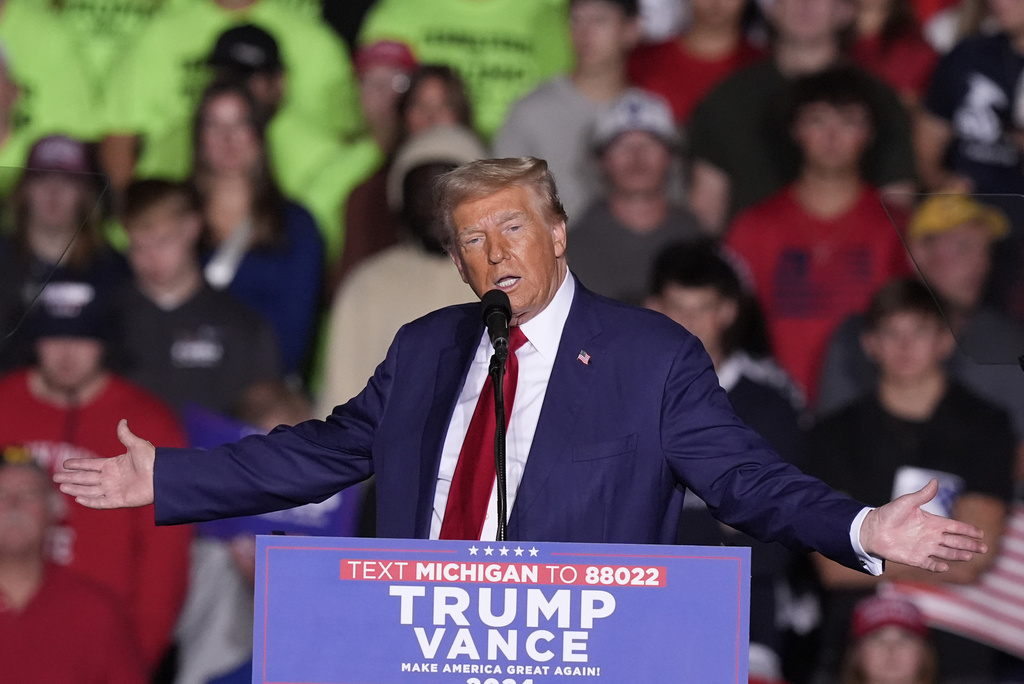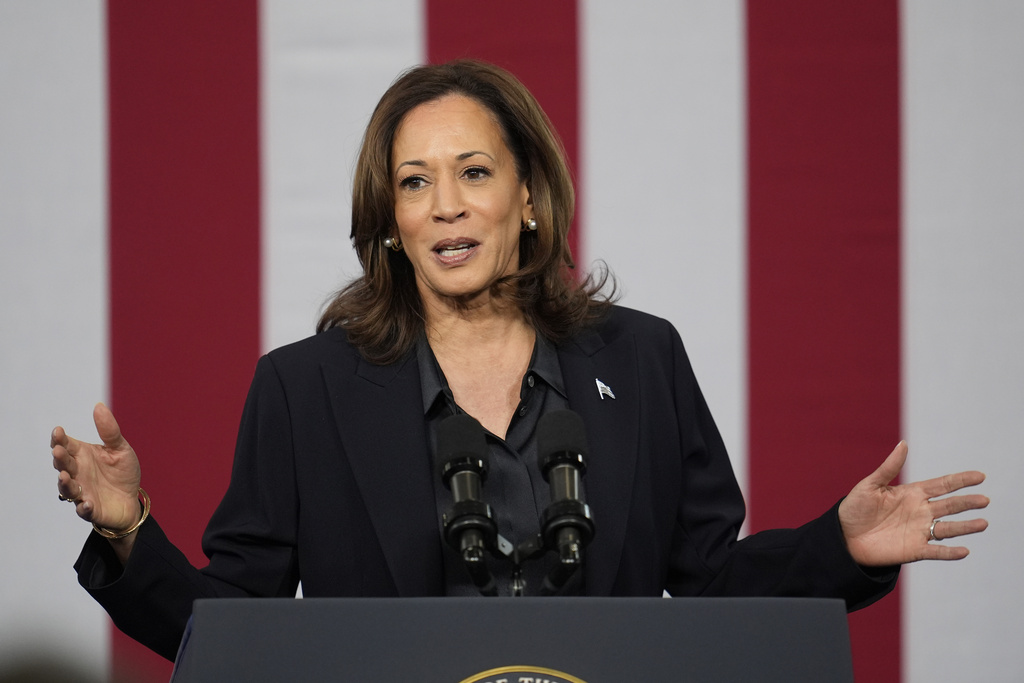Kamala Harris and Trump Compete for Michigan’s Union Voters \ Newslooks \ Washington DC \ Mary Sidiqi \ Evening Edition \ Vice President Kamala Harris visited Michigan, a critical swing state, to appeal to union voters as she competes against Donald Trump for working-class support. Following the suspension of a major U.S. dockworkers strike, Harris highlighted the importance of collective bargaining while also addressing concerns about auto industry jobs. Despite mixed support from unions, Harris received endorsements from major labor groups, underscoring the shifting dynamics in political loyalties among union voters.

Harris Competes for Union Votes in Michigan Quick Looks
- Michigan Visit: Kamala Harris visited Flint, Michigan, a union stronghold, to appeal to working-class voters.
- Strike Suspension: Her visit followed the suspension of a U.S. dockworkers strike, a significant development in the ongoing labor negotiations.
- Union Endorsements: While Harris received endorsements from key unions like the AFL-CIO, she lacked support from others, such as the Teamsters.
- Competing Messages: Donald Trump also courted Michigan’s working-class voters, claiming that Republicans are now “the party of the American worker.”
Deep Look
Vice President Kamala Harris traveled to Flint, Michigan on Friday, focusing on a key demographic: working-class voters. Flint, known as a union stronghold in the critical swing state of Michigan, is an important stop for Harris as she competes with former President Donald Trump for the support of blue-collar voters who could sway this year’s election.
Harris’s visit comes at a pivotal moment, following a significant labor development. U.S. dockworkers had just suspended their strike after reaching a tentative agreement aimed at raising salaries, averting what could have been a damaging episode of labor unrest. The agreement leaves some issues unresolved, but it marks an important step in avoiding economic disruption.
Harris praised the development, stating that it “indicates progress toward a strong contract and represents the power of collective bargaining.” She emphasized, “Dockworkers deserve a fair share for their hard work getting essential goods out to communities across America.” Her remarks were aimed at reinforcing her support for organized labor and the role unions play in ensuring fair wages and working conditions.
Emphasis on Collective Bargaining
Before delivering her evening remarks in Flint, Harris made a stop at a firehouse in Redford Charter Township, near Detroit. There, she expressed her gratitude to “labor brothers and sisters” and reiterated her support for union power, referring to the tentative dockworkers agreement as proof of the strength of collective bargaining. “We know, when union wages go up, all wages go up,” Harris told an audience that included representatives from various unions. “The bottom line is, when unions are strong, America is strong.”
Harris’s campaign also indicated that she planned to use her speech in Flint to attack Trump and his running mate, JD Vance, specifically on issues related to auto industry jobs. She intended to criticize Vance for his recent remarks during his campaign visit to Michigan, where he refused to commit to maintaining federal support for the General Motors plant in Lansing.
Struggles with Union Endorsements
Unions have historically been a reliable base of support for Democrats, but Harris’s efforts to secure key union endorsements have seen mixed results. This week, the International Association of Fire Fighters announced that it would not endorse a candidate, following a similar announcement by the Teamsters. Both unions had supported Joe Biden four years ago, marking a setback for Harris as she attempts to rally the labor community behind her campaign.
Nonetheless, Harris received some strong backing. Justin Pomerville, business manager at UA Local 85 in Michigan, planned to attend Harris’s event in Flint. He explained that a large portion of his members’ work hours are tied to projects funded by the CHIPS and Science Act, legislation heavily championed by the Biden administration. The act poured billions of dollars into semiconductor manufacturing, creating demand for skilled workers to lay intricate piping systems in these high-tech facilities. However, Pomerville acknowledged that many of his union members are not fully aware of the connection between the legislation and their employment. “Unless someone tells them they’re working because of that, they don’t know,” he said.
Mixed Labor Support for Harris
Despite setbacks, Harris still holds support from several key unions. Some Teamsters locals have endorsed her, along with endorsements from national teachers unions, the building trades, the AFL-CIO, and the United Auto Workers (UAW). These endorsements came quickly after she replaced Biden as the head of the Democratic ticket, suggesting continued faith in her commitment to labor issues among key labor leaders.
The divide within the labor community underscores a broader shift in American politics, with unions facing a split in loyalties. Democrats have increasingly drawn support from white-collar professionals, while Republicans, under Trump’s influence, have aimed to win over blue-collar workers, particularly those who did not attend college.
During a rally in Saginaw, Michigan, on Thursday, Trump claimed that Republicans are now “the party of the American worker,” glossing over his previous anti-union actions during his presidency. He promised that under his leadership, Americans “won’t have to go on strike for a better wage or a better life.” This rhetoric was clearly aimed at positioning himself as the champion of working-class voters, despite his historical record on labor.
Trump also recently visited Flint, in a move targeting the auto industry—a key pillar of Michigan’s economy. This has led to the two candidates campaigning in the same cities, sometimes even at the same venues, within days or weeks of each other, as they vie for Michigan’s crucial electoral votes.
Challenges in Communicating with Workers
Justin Pomerville, who also serves as president of the Tri-County Building and Construction Trades Council, described the challenge of communicating effectively with union members in the face of Trump’s messaging. “We’re voting our pocketbooks,” Pomerville said, emphasizing that labor leaders need to do more to explain the economic benefits of Democratic policies to their members. He warned, however, that Trump has been effective at “marketing false facts” that resonate with many union workers, particularly men who feel disillusioned with the political establishment. “When people try to talk about the election with them, you can watch some of their walls go up,” Pomerville added, noting the challenge of breaking through with facts.
While Harris focused on Michigan, Trump spent Friday in Georgia, where he appeared alongside Governor Brian Kemp—an indication that the former president had reconciled with the Republican leader in a key battleground state. Later in the day, Trump held a campaign event in Fayetteville, North Carolina.
Shifting Union Loyalties
Historically, union voters have leaned heavily toward Democrats, with 56% of union members supporting Biden in 2020. Trump, however, has made significant inroads among blue-collar workers, particularly white voters without college degrees. In 2020, he garnered 62% of the vote from this demographic, though he only received 24% of the vote from non-white workers without college degrees. The shift in support has been frustrating for Democrats, who point to the country’s strong labor market—254,000 jobs were added in September, surpassing expectations—as evidence of their success. President Biden has also demonstrated his support for unions, even joining a UAW picket line last year.
Harris’s Union Supporters Remain Confident
Not all labor voices are concerned about Harris’s prospects. Lisa Anderson, 59, traveled more than an hour from Green Bay to see Harris speak during a campaign event in Wisconsin on Thursday. Wearing a green “AFSCME for Harris-Walz” shirt, Anderson said she remains confident in Harris’s support for unions. “I’m not worried about it,” she said. “If you’re voting for Trump, how can you believe in unions?” Anderson, an elementary school administrative assistant for 17 years, expressed her faith in Harris’s labor credentials. AFSCME is the American Federation of State, County and Municipal Employees, and has historically been a strong supporter of Democratic candidates.
The dockworkers strike, had it continued, could have had a substantial impact on the presidential race by drawing attention to labor unrest and potentially leading to shortages on store shelves just as Election Day approached. However, the agreement to suspend the strike allows both parties some breathing room as they continue negotiations.
President Biden expressed his relief over the progress, saying from the White House, “We’ve been working hard on it. With the grace of God, and the goodwill of neighbors, it’s gonna hold.”
Kamala Harris and Trump Kamala Harris and Trump Kamala Harris and Trump







